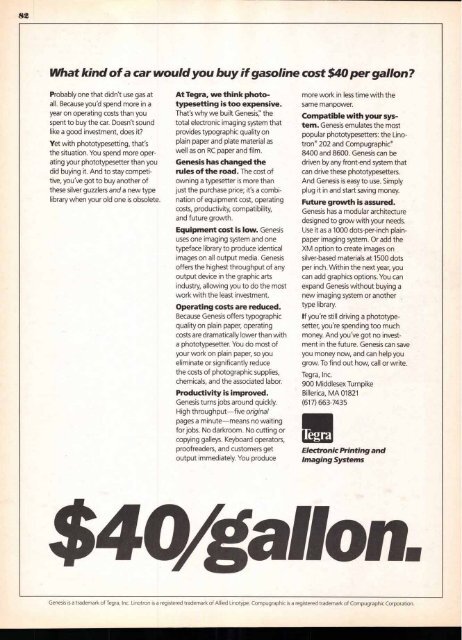Volume 12–4 (Low Res).pdf - U&lc
Volume 12–4 (Low Res).pdf - U&lc
Volume 12–4 (Low Res).pdf - U&lc
Create successful ePaper yourself
Turn your PDF publications into a flip-book with our unique Google optimized e-Paper software.
82<br />
What kind of a car would you buy if gasoline cost $40 per gallon?<br />
Probably one that didn't use gas at<br />
all. Because you'd spend more in a<br />
year on operating costs than you<br />
spent to buy the car. Doesn't sound<br />
like a good investment, does it?<br />
Yet with phototypesetting, that's<br />
the situation. You spend more operating<br />
your phototypesetter than you<br />
did buying it. And to stay competitive,<br />
you've got to buy another of<br />
these silver guzzlers and a new type<br />
library when your old one is obsolete.<br />
At Tegra, we think phototypesetting<br />
is too expensive.<br />
That's why we built Genesis, the<br />
total electronic imaging system that<br />
provides typographic quality on<br />
plain paper and plate material as<br />
well as on RC paper and film.<br />
Genesis has changed the<br />
rules of the road. The cost of<br />
owning a typesetter is more than<br />
just the purchase price; it's a combination<br />
of equipment cost, operating<br />
costs, productivity, compatibility,<br />
and future growth.<br />
Equipment cost is low. Genesis<br />
uses one imaging system and one<br />
typeface library to produce identical<br />
images on all output media. Genesis<br />
offers the highest throughput of any<br />
output device in the graphic arts<br />
industry, allowing you to do the most<br />
work with the least investment.<br />
Operating costs are reduced.<br />
Because Genesis offers typographic<br />
quality on plain paper, operating<br />
costs are dramatically lower than with<br />
a phototypesetter. You do most of<br />
your work on plain paper, so you<br />
eliminate or significantly reduce<br />
the costs of photographic supplies,<br />
chemicals, and the associated labor.<br />
Productivity is improved.<br />
Genesis turns jobs around quickly.<br />
High throughput—five original<br />
pages a minute—means no waiting<br />
for jobs. No darkroom. No cutting or<br />
copying galleys. Keyboard operators,<br />
proofreaders, and customers get<br />
output immediately. You produce<br />
more work in less time with the<br />
same manpower.<br />
Compatible with your system.<br />
Genesis emulates the most<br />
popular phototypesetters: the Linotron®<br />
202 and Compugraphic®<br />
8400 and 8600. Genesis can be<br />
driven by any front-end system that<br />
can drive these phototypesetters.<br />
And Genesis is easy to use. Simply<br />
plug it in and start saving money.<br />
Future growth is assured.<br />
Genesis has a modular architecture<br />
designed to grow with your needs.<br />
Use it as a 1000 dots-per-inch plainpaper<br />
imaging system. Or add the<br />
XM option to create images on<br />
silver-based materials at 1500 dots<br />
per inch. Within the next year, you<br />
can add graphics options. You can<br />
expand Genesis without buying a<br />
new imaging system or another<br />
type library.<br />
If you're still driving a phototypesetter,<br />
you're spending too much<br />
money. And you've got no investment<br />
in the future. Genesis can save<br />
you money now, and can help you<br />
grow. To find out how, call or write.<br />
Tegra, Inc.<br />
900 Middlesex Turnpike<br />
Billerica, MA 01821<br />
(617) 663-7435<br />
Electronic Printing and<br />
Imaging Systems<br />
$liOlgal on<br />
Genesis is a trademark of Tegra, Inc. Linotron is a registered trademark of Allied Linotype. Compugraphic is a registered trademark of Compugraphic Corporation.
















